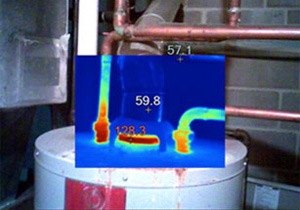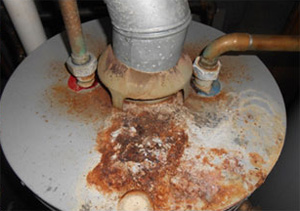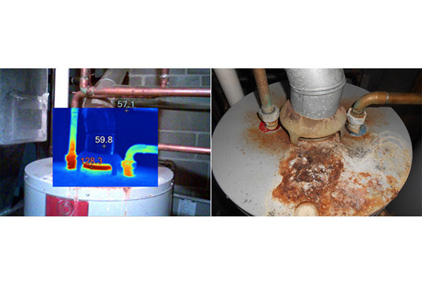This multiple-part article series will discuss the basics, codes and standards, and the science behind chimneys. It will show how back drafting affects chimney performance, while explaining the principles of positive pressure. It will explain how to create and use positive pressure so chimneys will draft for safety and performance.
Many cities have a combustion appliance zone (CAZ) policy to ensure the safe elimination of flue gases from the building. The U.S. Department of Energy (DOE) defines CAZ as any contiguous air volume within a building that contains a combustion appliance. The zone may include, but is not limited to, a mechanical closet, mechanical room, or the main body of a house. Back drafting is the spillage of combustion byproducts into the home, instead of venting out through the chimney or flue.
Since the byproducts of combustion, such as carbon monoxide, can be dangerous, they need to be vented properly.
Vented appliances that spill flue gases into the home for more than 60 seconds after startup are not drafting correctly.
According to Building Performance Institute (BPI) standards, any combustion appliance chimney or vent system that is in use must be visually evaluated for defects. A deteriorated chimney should be repaired or relined and the causes corrected before it is reused. A deteriorated vent system should be repaired or replaced.
For proper combustion, there must be sufficient supply air for complete combustion when all appliances are in operation simultaneously. It must be determined whether the CAZ is a confined or unconfined space per the National Fire Protection Association (NFPA). Air sealing a dwelling too tightly may result in the need to bring in outside air for combustion regardless of NFPA classification. The contractor must follow established standards for bringing in combustion air.
Confined and Unconfined Space

|
| How can you tell if a water heater is back drafting? Above is an infrared image. The outside temperature in this case is 49°F and the inside temperature is 71°. The mechanical room goes negative when the furnace blower is on low or high. This water heater does not draft without the furnace adding heat to the brick lined chimney. However, a 90 percent AFUE furnace has been installed with PVC flue and the water heater has been left on the old chimney. In the photo below, note the rust on top of the water heater and the rubber melted off the top. This water heater has been back drafting for 11 years. |
A confined space is defined as one where there is not enough air in the combustion appliance zone to provide for complete combustion when all home appliances are operating and the building is set for the worst case criteria.
An unconfined space is defined as one where enough air is present to provide for complete combustion when all combustion appliances are operating and the house is set for the worst case criteria.
 To apply the standard 1/20 rule, measure the volume of the CAZ. Add all input Btu ratings of the appliances in the CAZ. If an electric dryer is in the CAZ, consider an input rate of 100,000; for a gas dryer, consider an input rate of 125,000. Divide this total Btu by 20.
To apply the standard 1/20 rule, measure the volume of the CAZ. Add all input Btu ratings of the appliances in the CAZ. If an electric dryer is in the CAZ, consider an input rate of 100,000; for a gas dryer, consider an input rate of 125,000. Divide this total Btu by 20.
The resulting number is the cubic feet separating a confined from an unconfined space. If the volume of the CAZ is below the result, it is a confined space. If the volume of the CAZ is above the result, it is an unconfined space.
For example, consider a combustion appliance zone that measures 10 feet long by 14 feet wide by 8 feet high. The appliances in the CAZ include a gas furnace at 75,000 Btu input, a hot water heater at 40,000 Btu input, and a gas dryer at 125,000 Btu input.
In this case, the CAZ has a volume of 1,120 cubic feet. The total appliance input Btu is 240,000 Btu. Applying the 1/20 rule, 240,000 ÷ 20 = 12,000 cubic feet. The actual volume is below 12,000 cubic feet. Therefore, the CAZ is a confined space. The result is that additional combustion air must be brought into the CAZ.
Note that the above standard is based on an infiltration rate of less than .4 air changes per hour. When the rate of air changes per hour is known, for appliances other than fan-assisted, consult NFPA 54 8.3.2.2(1); for fan-assisted appliances, consult NFPA 54 8.3.2.2(2).
What is Draft?
Draft is negative pressure within a flue that pulls products of combustion out from the dwelling. Factors that affect draft pressure include delta T from indoors to outdoors; height of vent; interior volume; restrictions; atmospheric conditions; and pressure imbalances in the CAZ. Draft can be created from heat from the heating unit. If the flue is cold, back drafting is more likely to occur.
What is considered adequate draft? For an outdoor temperature greater than 80°F, it is a pressure greater than -1.0 pascal (Pa) or -.005 inches of water column (wc). For an outdoor temperature from 30° to 80°, it is a pressure greater than -2.5 Pa or -.01 inches wc. For an outdoor temperature below 30°, it is a pressure greater than -5.0 Pa or -.02 inches wc.
The most common factors for poor draft found in the field include: return air leaks in the basement; long horizontal vent connectors; blocked vents due to a deteriorated flue or bird nests; outside masonry flues with fan assisted heating appliances; fireplaces with no outside combustion air and without front enclosures; and overly tight houses.
(Part 2 will provide a discussion of venting categories.)
Publication date: 10/20/2014
Want more HVAC industry news and information? Join The NEWS on Facebook, Twitter, and LinkedIn today!


Report Abusive Comment